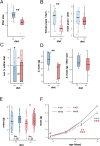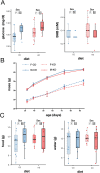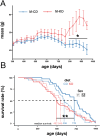Sex-dependent effects of a gestational ketogenic diet on offspring birth and lifespan
- PMID: 40674330
- PMCID: PMC12270155
- DOI: 10.1371/journal.pone.0328455
Sex-dependent effects of a gestational ketogenic diet on offspring birth and lifespan
Abstract
Low-carbohydrate, high-fat ketogenic diets (KDs) are used for treating drug-resistant epilepsy, and other potential benefits, such as treating neurological disorders, metabolic syndrome, and cancer are being explored. In addition to these and other medical applications, KDs have also become popular for rapid weight-loss and enhancing athletic performance. However, the potential negative effects of exposing developing offspring to KDs during pregnancy (gestational KD) are poorly understood, and especially the long-term health consequences. In this study, we investigated the effects of a partial gestational KD administered during the second half of pregnancy and assessed the consequences on the offspring over their entire lifespan. We found that, compared to controls, a gestational KD significantly reduced dams' litter size and litter mass and altered the litter sex ratio, reducing the proportion of female offspring, which also had lower body mass early in their life. In contrast, male offspring exposed to a gestational KD suffered a significantly reduced lifespan and a late-onset increase in body mass. We found no evidence that a KD diet influenced some adult offspring behaviors (locomotion, anxiety, depression, circadian rhythms, food and water consumption) or reproductive success. Our results with laboratory mice may not translate to human health, but nevertheless, they should raise concerns that even a partial maternal KD during pregnancy may have detrimental effects on offspring health and longevity.
Copyright: © 2025 Zala et al. This is an open access article distributed under the terms of the Creative Commons Attribution License, which permits unrestricted use, distribution, and reproduction in any medium, provided the original author and source are credited.
Conflict of interest statement
The authors declare that there are no conflicts of interest.
Figures







References
-
- Longhitano C, Finlay S, Peachey I, Swift J-L, Fayet-Moore F, Bartle T, et al. The effects of ketogenic metabolic therapy on mental health and metabolic outcomes in schizophrenia and bipolar disorder: a randomized controlled clinical trial protocol. Front Nutr. 2024;11:1444483. doi: 10.3389/fnut.2024.1444483 - DOI - PMC - PubMed
MeSH terms
LinkOut - more resources
Full Text Sources

